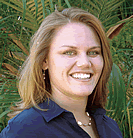The Answer Is in the Stars
##AUTHORSPLIT##<--->
In the search for a way to remedy our problems in math and science education, we should lookto NASA for help.
 SPACE HAS ENTHRALLED ME since I was old enough to stare into it. When I was a kid, my parents took my four siblings and me camping every summer. It was a week without electricity, TV, or private restrooms. We hiked all day and sat by the campfire at night, leaning back in our chairs to see the silvery constellations my dad pointed out. I was fascinated by how the stars frosted the darkness in a way this Los Angelino never got to experience elsewhere, without the help ofmajor power outages.
SPACE HAS ENTHRALLED ME since I was old enough to stare into it. When I was a kid, my parents took my four siblings and me camping every summer. It was a week without electricity, TV, or private restrooms. We hiked all day and sat by the campfire at night, leaning back in our chairs to see the silvery constellations my dad pointed out. I was fascinated by how the stars frosted the darkness in a way this Los Angelino never got to experience elsewhere, without the help ofmajor power outages.
I was fortunate to have a schoolteacher mother and a microbiologist father who passed along their awe of the universe to their children. And it doesn’t hurt that I live in an area partially built by the space race. Giants of space-flight history, such as Chuck Yeager and the flyboys who became some of the first astronauts, tested the power of flight in the Mojave Desert, a short drive from my home. The NASA Jet Propulsion Laboratory, which helped send Spirit and Opportunity to Mars, rests just a few freeway exits away, and on the rare occasion the space shuttle lands at Edwards Air Force Base, I get to experience nothing less than a sonic boom. Imagine a sound wave so massive that the force of it can set off car alarms more than 100 miles away from its origin.
It’s not just space travel that thrills me. So many of today’s major technological breakthroughs were born from work done by NASA. Numerous modern innovations—from solar-power electricity generators, ultrasound scanners, and firefighters’ breathing apparati, to shock-absorbing athletic shoes and Velcro—are owed to the space program. NASA changed the face of birthdays everywhere when it created Mylar, which is now used for balloons. NASA also has a place in education, offering great programs that can be solid alternatives to many of the pricey commercial curriculum supplements. Several major challenges face our school system. To not attempt to address these issues with academic resources our tax dollars pay for seems one of the country’s greatest education follies.
NASA’s website and the resources available there are in the public domain; the materials on the site are free to all. This puts some of the most recent discoveries in science and technology within reach of every educator. On the site, students can find interesting answers to the most compelling questions, including the age-old, “How do astronauts use the bathroom in space?”
NASA’s website divides its educational resources into age groups, catering to each audience. There are separate pages for K-4, 5-8, 9-12, and postsecondary groups, along with Virtual Lab, Kids’ Club, NASA TV, news about missions, and trivia about space and the people who have journeyed there. So much of what is on the site can be used to enhance physics, biology, engineering, and history lessons, as well as highlight examples of technological innovation and provide interesting information about the astronauts and many other people who work to make space travel possible.
We have tried many strategies to reverse our students’ poor performance in math and science. The struggle is simply getting students interested. NASA can do the trick.
— Caitlin Werner, Assistant Editor
Correction: In our August Commentary, the Cable in the Classroom website should have been identified as www.ciconline.org. We regret the error.